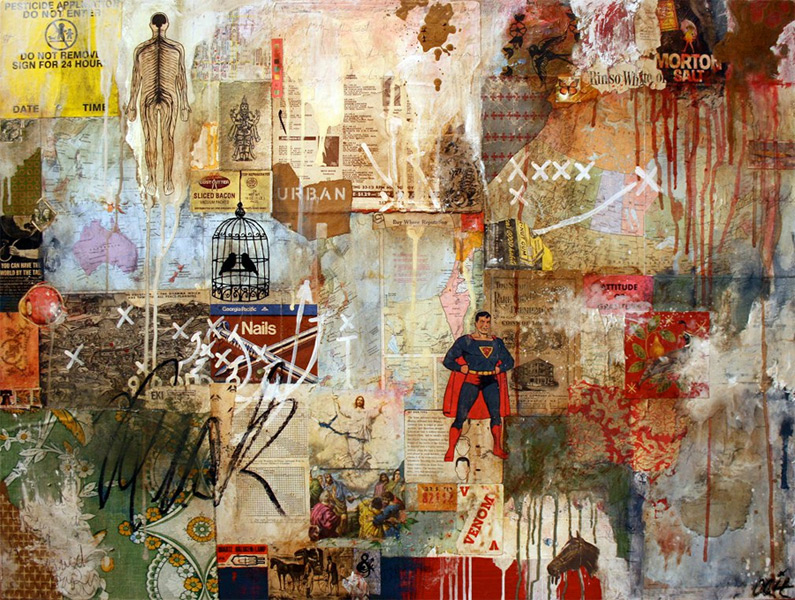How to Write Artist Statements Without Writing Anything

For those readers who don’t know, along with being a writer and editor, I am also an artist. Despite this combination of talents, I’m not sure I really know how to write artist statements.
I can say that I’m an “artist” fairly because I actually sell work (though not enough to make a full-time living) and show fairly regularly in some pretty great galleries on the Twin Forks and beyond. But I, like many artists I know, often struggle with talking about my work in a clear, concise manner. And writing a proper artist’s statement has always been difficult.
A quality artist’s statement should explain one’s work visually while also discussing the meaning or subtext of said work. A great many of these statements are utterly pretentious trash and they typically try way too hard to make the artist and his or her work sound smart and deep and poignant. The statement will usually reference other artists, or even writers and thinkers if you’re particularly sly. The idea, I suppose, is to help give some context for the work and encourage collectors to buy into whatever idea you’re selling—which will then, hopefully, lead to that collector buying an actual painting or sculpture.
Few artists’ statements do this well. In fact, most are tremendously embarrassing. Actually, most art writing overall is pretty embarrassing. This is not to say there aren’t some great reviews and statements out there, but most are overwritten, overwrought tripe.
In my own art writing—and I do a fair amount of it (including my weekly “Work on Monday” column on DansPapers.com)—I aim to communicate thoughts and ideas with simple clarity. When writing about a painting or a show, I really try not to alienate readers with lofty concepts or totally obscure references.
I hoped to do the same with my own artist’s statement, though I’m sure plenty of people would argue that both my art criticism and artist’s statement are as difficult and pretentious as the best of them. Hopefully not.
So, want to know how to write artist statements?
Look at my painting above [“Risk,” mixed media on canvas, 2011] and then read the statements below.
First, read the actual statement I’ve used, with slight variation, over the last few years:
Oliver Peterson
b. 1976 New York, NY.
Water Mill, NY resident Oliver Peterson finds inspiration in graffiti, structural decay, the pop zeitgeist, literature, politics, history, advertising, religion, the occult, Victorian era medicine and modern heroic figures cut from the pages of comic books and other sources. This diverse subject matter and iconic imagery drives the artist’s work to challenging places, but Peterson’s paintings are very much about the media from which they are built. The artist frequently experiments with paint and patinas and often applies random studio detritus to compositions that have been described as energetic, complex, dark, masculine and even gentle. Peterson was chosen as a Long Island Pulse Artist VIP in 2008, and his work has been featured and illustrated in The New York Times, The New York Daily News, Newsday and nearly all of the local publications in the renowned Hamptons region on the East End of Long Island.
***
“Pop zeitgeist,” you say? Why “detritus” and not trash, you ask?
OK, so I’m not totally immune to adding some panache here and there, but I’ve tried to be somewhat brief and to the point, while also noting some accomplishments and things others have written about my stuff. Like I said in the beginning of this blog—writing a proper artist’s statement has always been a bit difficult. The real question is whether or not this statement is pretentious enough?
Luckily, I’ve found a tool online that takes away the guessing and does the work for me. The outcome is absolutely ridiculous, but the 500 Letters Artist Statement Generator asks just a few questions and spits out what many would call a legitimate description of my work. I’m guessing I could show my 500 Letters-generated statement to 100 people and at least 75 of them would nod approvingly rather than admit that it’s confusing or seems stupid. A quarter of them could even be educated on the arts.
Now read the generated statement and judge for yourself. (Be honest—what would you say if an artist asked your opinion?):
Oliver Peterson
Oliver Peterson (°1976, New York, NY – United States) creates mixed media artworks and paintings. By emphasizing aesthetics, Peterson presents everyday objects as well as references to texts, painting and architecture. Pompous writings and Utopian constructivist designs are juxtaposed with trivial objects. Categories are subtly reversed.
His mixed media artworks often refers to pop and mass culture. Using written and drawn symbols, a world where lightheartedness rules and where rules are undermined is created. By using popular themes such as sexuality, family structure and violence, he seduces the viewer into a world of ongoing equilibrium and the interval that articulates the stream of daily events. Moments are depicted that only exist to punctuate the human drama in order to clarify our existence and to find poetic meaning in everyday life.
He creates situations in which everyday objects are altered or detached from their natural function. By applying specific combinations and certain manipulations, different functions and/or contexts are created. With the use of appropriated materials which are borrowed from a day-to-day context, he touches various overlapping themes and strategies. Several reoccurring subject matter can be recognized, such as the relation with popular culture and media, working with repetition, provocation and the investigation of the process of expectations.
His works sometimes radiate a cold and latent violence. At times, disconcerting beauty emerges. The inherent visual seductiveness, along with the conciseness of the exhibitions, further complicates the reception of their manifold layers of meaning. Oliver Peterson currently lives and works in Water Mill, NY.
[I only altered British spellings to American. Otherwise the above is exactly as created by 500 Letters]
***
What do you think? Is it obvious rubbish?
Now make your own artist’s statement at 500 Letters (500letters.org) and share in the comments below or on our Facebook page.
You can also email them to me. Maybe I’ll share my favorites. Extra points if you’re a known East End artist!



